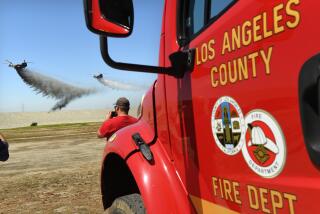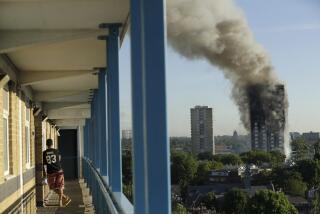One year after a firefighter’s deadly fall, L.A. is fighting an order from state safety regulators
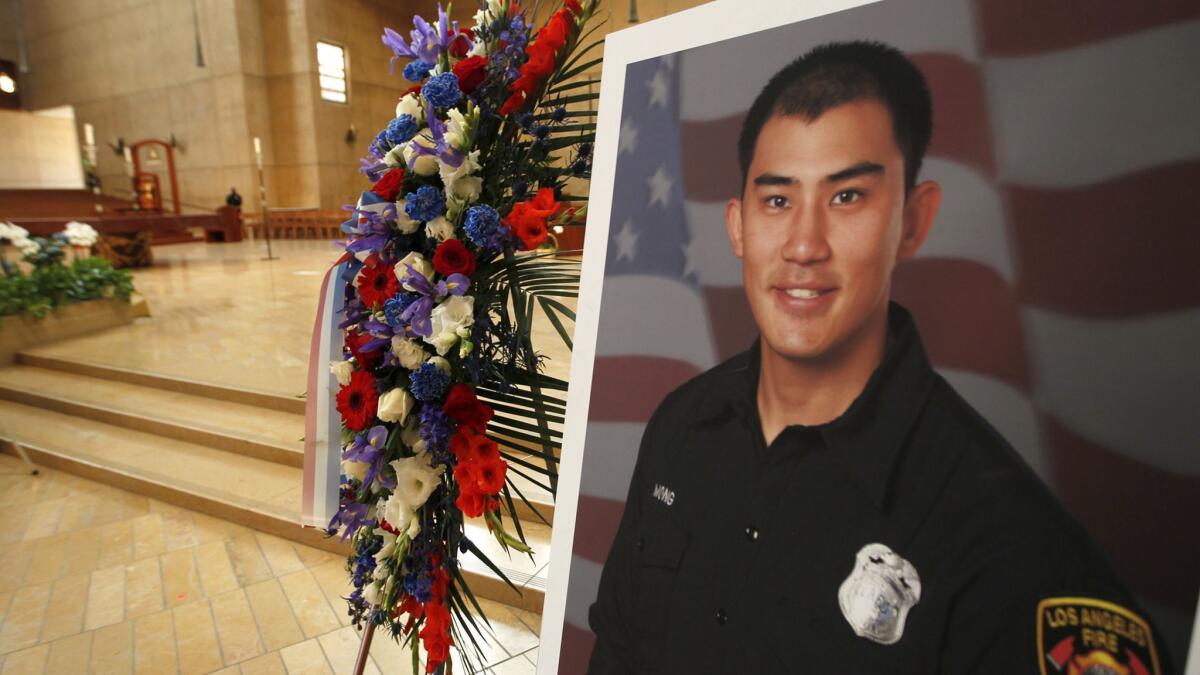
It was supposed to be a routine training exercise: firefighters climbing a ladder to the roof of a six-story building in downtown Los Angeles, as though the structure were on fire.
On that June morning in 2017, firefighter Kelly Wong made it more than halfway up the ladder, leaning against the Barclay Hotel at a 73-degree angle. But then the 29-year-old lost his footing, falling from the ladder onto the fire truck below. He died from his injuries two days later.
Now, lawyers for the Los Angeles Fire Department are at odds with workplace safety regulators over their investigation into the incident, the first fatality during a department training exercise since 1985.
Officials with the state’s Division of Occupational Safety and Health, or Cal/OSHA, sent the Fire Department a special order in December instructing it to establish and implement procedures for using aerial ladders safely. The department must ensure that workers maintain three points of contact with a ladder at all times — either two hands and one foot, or two feet and one hand, Cal/OSHA said in its order.
After visiting the accident site, safety regulators concluded that Wong had been holding a Fire Department “roof kit,” or two metal hooks strapped together, while he was on the ladder.
“The incident was caused by [Wong] carrying the roof kit in his hand, rather than secured to his back, thereby not allowing him to maintain three points of contact while ascending the ladder,” state officials wrote in their two-page narrative on the incident.
Cal/OSHA officials said their order will require the city to take corrective steps to prevent serious and fatal falls in the future. But the Fire Department has filed an appeal, calling the order “vague and ambiguous” and arguing that it provided little guidance on how to comply.
In the appeal filing, Deputy City Atty. Jorge M. Otaño said some of the order’s instructions would hamper the department’s work in saving lives. “As worded, many rescues would be a violation of the order and cause unnecessary delay or hazard,” he wrote.
Cal/OSHA officials say they issue special orders to “correct an unsafe condition, device, or place of employment which poses a threat to the health or safety of employees” — and which is not covered by existing state regulations. In the Wong case, the agency said the Fire Department cannot allow workers to transport tools in ways that put them at risk of falling from ladders.
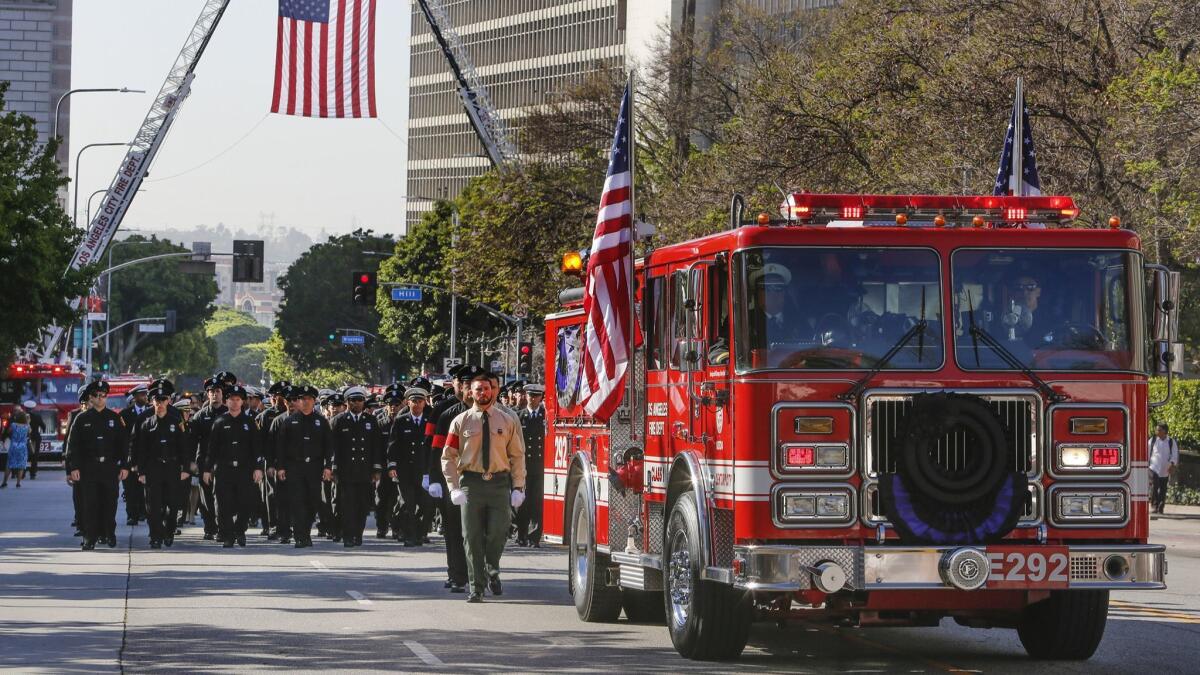
Peter Sanders, a spokesman for the Fire Department, said Fire Chief Ralph Terrazas would have no comment on the incident until the city resolved its issues with Cal/OSHA. But he confirmed the department currently has no written policy or procedure for carrying a roof kit while ascending a ladder.
Sanders said department officials are updating their policies on the safe use of ladders, which will clarify how tools should be carried. The language is expected to say that firefighters “have to have both of their hands free to climb ladders,” Sanders said. “And that when they take tools up ladders, they do so in a way where they don’t need to use their hands to hold the equipment.”
Sanders said the wording changes, expected later this summer, are a result of the department’s ongoing evaluation of safety procedures — and not a response to Wong’s death.
Meanwhile, the Fire Department is also contesting $2,060 in fines issued by Cal/OSHA in the wake of the incident.
After reviewing the scene of the fatal training session, state regulators cited the Fire Department over its handling of ladders, its procedures for identifying workplace safety hazards and its strategies for keeping workers from experiencing heat-related illnesses, according to records provided by Cal/OSHA.
Rob Wilcox, a spokesman for City Atty. Mike Feuer, had no comment on those citations. But in the city’s appeal documents, the Fire Department maintained that it has procedures to ensure workers obtain water and shade and that training on workplace hazards is provided regularly.
City firefighters are “constantly exposed to new substances, processes or equipment as the nature of the occupation, i.e. fire rescue and suppression, is a constantly changing environment with unpredictable variable,” the city’s lawyer wrote in its appeal.
The Times asked two members of the Board of Fire Commissioners, a panel appointed by Mayor Eric Garcetti, about the city’s decision to contest Cal/OSHA’s order and citations. Both commissioners — Andrew Glazier and Rebecca Ninburg — said they were not aware that Cal/OSHA had sent the order and proposed fines.
Glazier said he was “troubled” that department officials had not informed him of the state’s involvement. “I don’t know why nobody told me,” he said. “It should be a matter of course that we would be kept informed.”
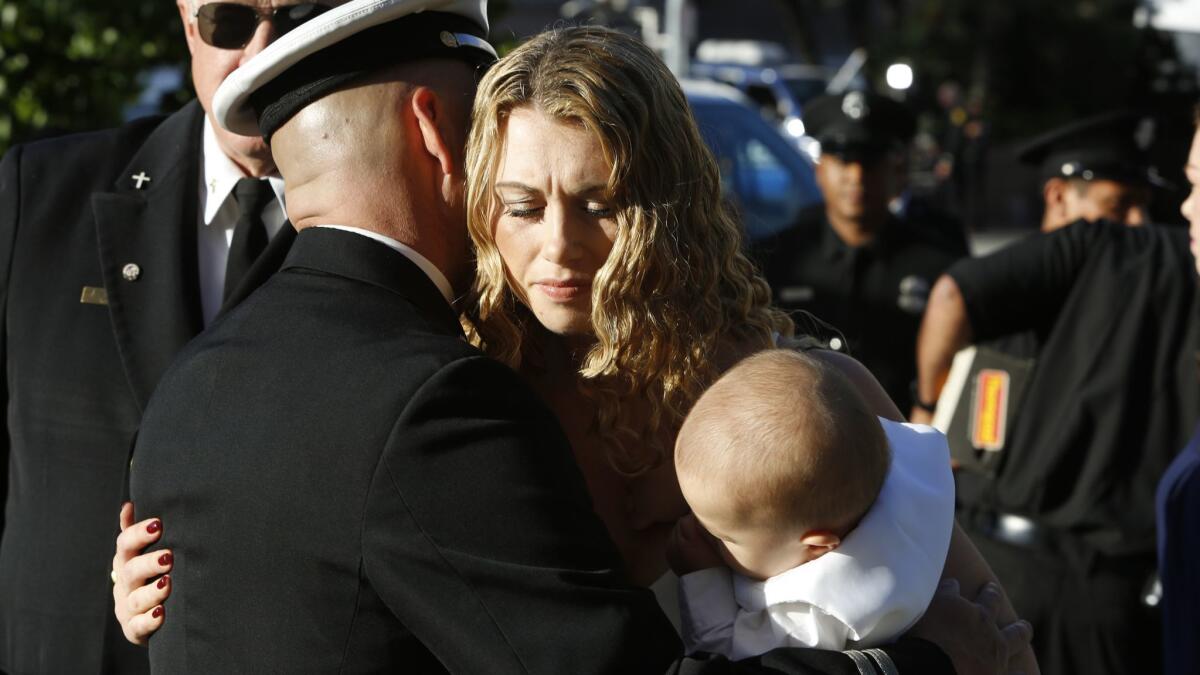
Wong had been with the Fire Department about two years on June 3, 2017, the day he took part in the training exercise at 4th and Main streets.
The exercise called for Wong to climb a ladder extended 86 feet, according to a preliminary report from the Fire Department. Wong was the assigned “top member,” or the first person to reach the roof.
During the training session, Wong was wearing a breathing apparatus and carrying the roof kit, whose hooks are used to pry away roofing materials after a hole is cut in a roof. Those hooks are typically carried with a strap on a firefighter’s back or shoulder, said Sanders, the Fire Department spokesman.
The department’s preliminary report does not explain why, as Cal/OSHA noted, Wong had the roof kit in his hand. By the time he lost his balance, two other firefighters were on the same ladder, the department’s report said.
Wong fell between 55 and 65 feet and was transported to Los Angeles County/USC Medical Center with critical traumatic injuries. He died June 5.
Shortly after Wong’s death, the Fire Department conducted a three-day “safety stand down,” with personnel going over an array of procedures, including use of aerial ladders.
The department launched its own review of the incident. Sanders said there is no timeline for the completion of the report, which is not expected until after the Cal/OSHA appeals process is over.
The next hearing on the Cal/OSHA order and citations is in October.
Cal/OSHA officials said the three citations focus on conditions that were identified by regulators on the scene but not related to Wong’s death. One citation said the Fire Department had been using its aerial ladder in a manner “contrary to manufacturers’ recommendations,” by failing to extend it above the roof line of the Barclay Hotel.
Otaño, the deputy city attorney, disputed those conclusions, saying in the city’s written appeal that extending the ladder above the roof can be “contrary to the safety of the employee.” He warned the practice could also prevent the department from carrying out its core mission — saving lives and rescuing members of the public.
Twitter: @DavidZahniser
More to Read
Sign up for Essential California
The most important California stories and recommendations in your inbox every morning.
You may occasionally receive promotional content from the Los Angeles Times.

